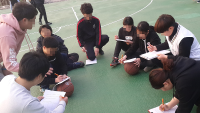
Purpose The purpose of this study was to empirically analyze the relationship between a commercial sports centers employees’ empathy, job satisfaction, customer orientation, service quality & organization loyalty through structural equation model analysis. Methods For this purpose, this study set 205 employees’ at the eleven commercial sports centers located in Seoul as the research subjects. In an effort to verify the proposed structural model, this study used IBM SPSSWIN Ver. 21.0 and AMOS 18.0. Results First, cognitive empathy had a positive effect on job satisfaction. Second, emotional empathy had a positive effect on job satisfaction. Third, communication empathy had a positive effect on job satisfaction. Fourth, job satisfaction had a positive effect on customer orientation. Fifth, job satisfaction had a positive effect on service quality. Sixth, job satisfaction had a positive effect on organization loyalty. Seventh, customer orientation didn’t had a positive effect on organization loyalty. eighth, service quality had a positive effect on organization loyalty.

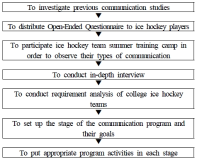
This study was designed to develop a communication training program for college ice hockey teams and examine the effects of this program. College ice hockey players and coaches participated in this study. The various types of data were collected and analyzed to assess the needs of the program and to develop the program with expert meetings. To analyze the effects of the developed program, questionnaires, experience reports, and in-depth interviews were conducted as measures. The results of this study are as follows. First, ice hockey team communication consisted of eight factors (i.e., sympathy, respect, trust, two-way verbal communication, firm expression of opinion, training program communication, developing rapport, and cohesion). Thus, the program developed based on eight factors and consisted of three stages of total 12 sessions which was 90 min to 100 min long. Second, this program increased communication satisfaction, coach-athlete interaction, group cohesion and exercise effectiveness, and these quantitative results were statistically significant. Moreover, qualitative analysis revealed that this program enhanced sympathy, social cohesion, and task cohesion among participants as well as positively changed their communication skills better than before. The communication training program which was developed through this study could provide basic information of a communication training program in the sports domain and positively influence overall sports team effectiveness and performance.


The purpose of this study was (1) to develop instructional contents for teaching and learning sportsmanship and (2) to examine the perceptions of sports instructors on that contents. Instructional contents based on sympathy was constructed from Youtube clips. Final version was developed to apply situated learning in class and was comprised of twenty-sportsmanship video clips and worksheets. Participants were sports instructors (N=208) in elementary and middle schools. Open-ended question and interview on call were used to collect the data. Qualitative content analysis was used to analyze the instructors’ perception regarding instructional contents. Results of this study showed that sports instructors responded to the contents as thoughtful experience (1) making myself realize the value of opponent, (2) making myself realize the value of sports, (3) making myself realize the value of judge, (4) making myself realize the value of coach/athlete. This study concluded that instructional contents was touching and emotional. Implication of instructional contents for teaching and learning sportsmanship, pros and cons of the contents and teaching tips were discussed.



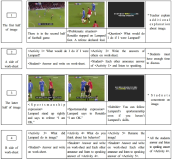
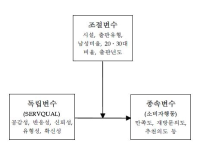
The current study aimed to investigate the impact of SERVQUAL on sport consumer behaviors using meta-analytic techniques. Findings from 25 dissertations and 26 journal articles were used to test of a model of the SERVQUAL on various sport consumer behaviors via the comprehensive meta analysis (CMA) program. Results showed that SERVQUAL has a large effect on sport consumer behaviors, with a fixed effect size of .383. In terms of the relative importance of the SERVQUAL sub-factors, sport consumer behaviors were influenced most by empathy, followed by reliability and tangibles. In predicting sport consumer behaviors, SERVQUAL had a most positive effect on, in order of, loyalty, customer orientation, and commitment. Results also found significant moderating evidence for sport facility types, publication types, publication year, the ratio of male and respondents' age.

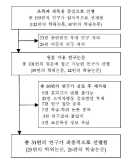




PURPOSE This study aimed to empirically investigate the influence relationships between the ESG activities of professional sports teams and sports fans’ team recognition, team preference, self-determination, and voluntary action intention. METHODS From March 1, 2022, to May 31, 2022, a survey was conducted online and offline to secure 253 copies of the final valid study samples. Descriptive statistics, frequency analysis, correlation analysis, reliability analysis, confirmatory factor analysis, and structural equation model analysis were performed using SPSS 24.0 and AMOS 18.0. RESULTS First, it was found that ESG activities in professional sports teams had a positive effect on sports fans’ team recognition, team preference, self-determination, and voluntary action intention. Second, the team recognition and team preference of sports fans of a given professional sports team had a positive effect on their self-determination and voluntary action intention. CONCLUSIONS The study results showed that ESG activities must be enjoyed not only by a given club’s sports fans but also by its stakeholders. The results suggest that gaining empathy regarding sports fans increases awareness and preference, which can lead to long-term and deeply positive effects on self-determination and voluntary action intentionl.

Purpose This study aims to investigate the experience of service yips in badminton players in depth through using grounded theory method. Methods We collected data from in-depth interviews with 14 participants in total, consisting of badminton players who experienced service yips, their doubles partners and coaches. The collected raw data were analyzed base on derive transcription, coding and paradigm models through grounded theory method. Results First, as a result, 59 concepts, 31 subcategories and 15 categories in regard to badminton service yips were deduced from open coding. Second, in axial coding, it was structured in a paradigm model by categories such as service yips, service mistakes, service proficiency, service anxiety, the imprinting experiences, the importance competition, the pressure of achievement, service practice, psychological control, tactical handling, support from partners, leaders’ coaching, advice from experienced ones, overcoming yips and persistent yips. Third, selective coding resulted in ‘Badminton service yips’ as the core category of this study. ‘Badminton service yips’ is a chronic performance impairment associated with badminton players making severe errors in swing motion on a service not intended by them that it is due to physiological or psychological symptoms such as hand tremors, overall body stiffness, arms stiffness, overstress, overanxiety, and concern over service mistakes. Conclusions We expect our study can be a theoretical foundation for understanding and explanation of ‘Badminton service yips’ and a useful reference for badminton players suffering from psychological difficulties caused by their service yips. The findings in this study should be considered for the development of potential strategies for overcoming the badminton service yips.

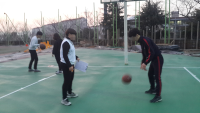
Purpose The purpose of this study was to further understand how out-of-school adolescents’ self-esteem and interpersonal relations have changed in a peer mentoring basketball program and what they have experienced for the program It was action research of qualitative research method. Methods 4 out-of-school adolescents in the adolescents Center of C-si were selected as the participant. The data was collected by in-depth interviews, participant observation, and research journal. The collected data was then analyzed by an inductive categorical system. Results The findings were summarized as follows: the out-of-school adolescents showed somewhat low self-esteem and difficulties of interpersonal relations at an early stage participating in the peer mentoring basketball program. However, their self-esteem and interpersonal relations have been gradually changed during the program. First, they participated in various mentoring activities and self-expression activities. Their self-esteem has been improved as they found their real values, communicated with others, and lived with their confidence. Second, they overcame personal relations with fear and indifference of others, extended personal relations, and sympathized with others to solve the problem that they had as interpersonal relations. Conclusions The out-of-school adolescents has positively changed their self-esteem and interpersonal relations through the peer mentoring basketball program. We expect that out-of-school adolescents could overcome their difficulty and live well their life in the future.

